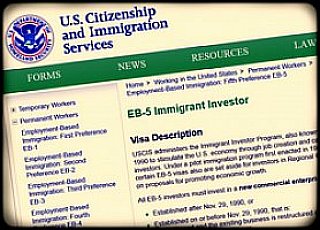
The temporary shutdown of the government, due to the conflict between the president and Congress over funding the Wall, will suspend about 95 percent of the activities in the immigrant investor (EB-5) program, but you cannot tell that from the conflicting messages that USCIS has issued on this admittedly complex subject.
One message says:
Some USCIS programs, however, will either expire or suspend operations, or be otherwise affected, until they receive appropriated funds or are re-authorized by Congress. These include:
- EB-5 Immigrant Investor Regional Center Program (not the EB-5 Program). Regional centers are a public or private economic unit in the U.S. that promotes economic growth. USCIS designates regional centers for participation in the Immigrant Investor Program. The EB-5 Program will continue to operate.
Another message, issued at about the same time (also provided, appropriately, in Simplified Chinese), declares:
The EB-5 Immigrant Investor Regional Center Program expired at the end of the day on Dec. 21, 2018, due to a lapse in congressional authorization to continue the program.
So is the EB-5 program going to continue or not?
The reality, which USCIS fails to explain, is that something like 95 percent of the EB-5 program is no longer authorized, and about 5 percent remains. This has nothing to do with the lack of money to pay the feds; that is another matter.
The part of EB-5 that has ground to a halt is that which allows regional centers to provide visas to aliens making $500,000 investments in government-recognized (but not government-guaranteed) projects; that which will continue is the tiny portion of the program that grants visas to those making $1 million investments in businesses in this country. The two segments of the EB-5 program have different congressional authorizations; the million-dollar one is permanent, the half-million-dollar one is temporary; the latter expired on December 21 after a long series of short-term extensions patched onto spending bills.
The first of the two USCIS statements includes this sentence: "Regional Centers are a public or private economic unit in the U.S. that promotes economic growth."
In this single sentence, over and above the mauling of the plural/singular variable, we have two bits of pro-EB-5 propaganda. There are 889 regional centers; all but two or three are private-for-profit entities, the others are municipally sponsored. There were, historically, three state-run regional centers, but all have been put out of business because of scandals. So if the population consists of 886 private entities, and maybe three public ones, why are they described as "public or private" when the phrase should be "private or public".
Further, the government should have said that the centers were "designed to promote economic growth" because that is an accurate statement.
The vast majority of the 889 regional centers have either done nothing and therefore lost money, or have not handled enough projects to break even. Since there is a cap on the number of visas available (10,000, representing about 4,000 investments) and there is no cap on the number of regional centers, each of the 889 centers, on average, gets fewer than five investments a year, guaranteeing losses for the vast majority of centers. So, the average regional center does not promote anything but bills from lawyers and consultants.
The numbers noted above — the 899 and the 10,000 (or 4,000) — are never linked in government texts.
An Aside. Speaking of bureaucratic language, as we were, reminds me of a recent change in the Washington verbiage.
One of the odd elements of the Trump administration is the large number of presidential appointment positions, and other major policy-making jobs, that remain vacant, perhaps an indication of the president's own lack of interest in detailed government policies.
That's not news, but a recent Department of Homeland Security press release contained an implied recognition of this trend in the very title of an official making a routine announcement. He is William N. Bryan, "Senior Official Performing the Duties of the DHS Under Secretary for Science and Technology". (Emphasis added.)
Maybe I have missed something, but it is only recently that I have started seeing such a title, all spelled out with capital letters. It is reminiscent of the Artist Formerly Known as Prince.
An under secretaryship is one of the top three to five jobs in a federal department, ranking after only the secretary and the deputy secretary, and perhaps a more senior under secretary or two. All under secretaries have precedence over all of the more numerous assistant secretaries, who of course outrank the principal deputy assistant secretaries and the still more numerous deputy assistant secretaries. A more thorough analysis would report the places on the ladders held by the deputy under secretaries, but that may vary by department.
In this case, the acting under secretary of DHS for science and technology, to use the previous (and briefer) terminology, was announcing a competition for the design of what might be called a gas mask to be worn in situations involving fires with dangerous chemicals.
Maybe by the time DHS has figured out who has the best invention, the award can be announced by someone carrying the straight-forward title of under secretary of DHS for science and technology.
